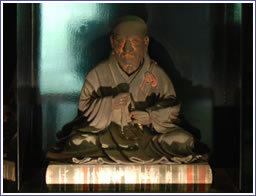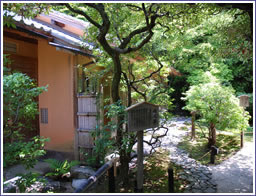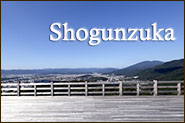Top ¡ä History of Shoren-in
Shorenin temple is one of the five Monzeki temples of the Tendai sect in Kyoto*; the head priests at these temples originally belonged to the imperial family.
* The Tendai sect's five Monzeki temples
in Kyoto are as follows: the
Shorenin, Myohoin, Sanzenin, Manshuin,
and Bishamondo temples.
Shoren-in temple was formerly a part of Enryaku-ji Temple on Mt. Hiei, which is the main temple of the Tendai Buddhist sect.

The name of the temple is derived from Shoren-bo, one of the several lodging facilities for priests built at the top of Mt. Hiei when Saicho, the founder of the Tendai sect, started his preaching at Mt. Hiei. It was one of the main lodging facilities in the mountain used as the residence of several well-known priests in Tendai sect, including Saicho, En-nin, An-ne, and So-oh, who succeeded the sacred lantern that keeps an eternal light.
The retired Emperor Toba, a believer of Gyogen and the twelfth head priest of the Enryaku-ji Temple, made his seventh son study under Gyogen's control. He built a residence for them in Kyoto, which was designed in a style similar to that of his own imperial residence and named it " Shoren-in".Thus, Gyogen became the first head priest of the Shoren-in temple followed by Prince Kakukaishin-no, TobaŽÕs son. Shoren-bo on Mt. Hiei served as a lodging facility for the priests of Shoren-in temple until the Muromachi era. Moreover, until the Meiji era, only members from the imperial family or from the regent family could become head priests of Shoren-in temple.

Shoren-in temple enjoyed its highest prosperity under the third head priest Jien, who served from the end of the Heian era through to the Kamakura era. While serving as the head of the Tendai sect for four terms, Jien contributed in numerous ways to the world of Buddhism in Japan; he won the respect of the imperial family and promoted the discipline of controlling one's own mind by the imperial order. Further, he achieved success in his academic career by writing Gukansho, the immortal classic and the first book of philosophy based on Japanese history, and by compiling Shugyokushu, a collection of his poems. After being awarded a Master of Esoteric Buddhism, he provided a sanctuary to Ho-nen,the founder of the Jodo sect, and also to Shinran, the founder of the Shin sect. Following JienŽÕs footsteps, Shinran, at the age of nine, entered priesthood at Shoren-in temple. Since, until the Meiji era, all the head priests of Honganji were required to enter priesthood at Shoren-in temple in order to be officially recognized as head priests, Honganji was awarded the title of being affiliated with Shoren-in temple.
Prince Son-en, the seventeenth head priest of Shoren-in temple and one of the sons of Emperor Fushimi, was known as a distinguished calligrapher who created a unique handwriting style that combined both the traditional Japanese and Chinese styles. Following Prince Son-en, all head priests inherited his handwriting style and became the grand masters in the world of Japanese calligraphy.

After the Imperial Palace was burnt down during the Tokugawa era, the retired Emperor Gosakuramachi settled in Shoren-in temple for sometime; it served as her temporary Imperial Palace and Kobuntei in the garden served as her study room.








